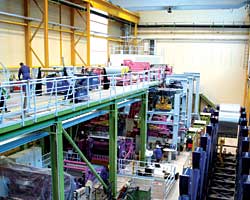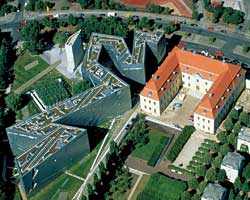Architectural Zinc: From Gray to Green
|
||||
The Environmental Profile of Zinc in Buildings: Green Life Story
The current process for extracting, processing and recycling zinc materials is based on technological innovations, some only a few years old, and continuing at a rapid pace, to save energy, contain and re-use potentially harmful by-products, and recycle material at every phase.
Its low embodied energy is one important way that zinc is a green material. Embodied energy includes the total amount of non-renewable energy needed to create one unit of a finished product, including raw material extraction, transport, manufacturing, assembly and installation, and in detailed calculations, to maintain during its useful life and dispose of afterwards. The terms "cradle to grave," "cradle to cradle" and "total cost of ownership" describe this.
Among the non-ferrous metals used in building, zinc has the lowest embodied energy. It is the least energy intensive to produce, requiring one fourth the energy of aluminum, and one third that of copper or stainless steel. Zinc is less expensive to extract than many other metals, and requires lower heat and less energy to process.
Raw Material and Resource Consumption:Zinc is the 23rd most abundant element in the earth's crust. Increased recycling, currently at a yearly rate of over 30 percent of overall zinc consumption, is also expected to increase and to compensate for future growth in consumption. Zinc is mined worldwide, and various projections have been made for the size of the global supply, but estimates put it up to 750 years at current extraction levels.
Mining: Zinc is predominantly mined from deep mines as opposed to strip mines. Core extraction mining, although more expensive, requires less energy, disturbs less land and risks less environmental damage than strip mining. Zinc is easier to extract than other metals, requiring less gross energy consumption. Zinc alloy manufacturers also have the option of purchasing zinc ingots from suppliers who contract with environmentally conscious mining companies. Current global sustainability initiatives and increased regulatory scrutiny are driving new energy efficient and ecologically low-impact processes.
Smelting and Processing: Emissions during these phases are reduced to a minimum through state of the art manufacturing equipment including new furnaces, heating and cooling systems and electrofilters and other abatement systems that minimize waste and pollution, conserve energy and limit the release of emissions. Zinc has a low melting point of 786 °F (419 °C) compared to aluminum at 1120 °F (660 °C), copper at 1983 °F (1084 °C), and steel at 2372 °F (1300 °C) resulting in lower energy requirements at the smelting stage of production.
Maintenance:The installation of zinc products on job sites typically results in very little pollution and little or no waste, since even scraps have resale value. As discussed above, repair and maintenance costs tend to be minimal throughout the life of the building.
Replacement and Disposal-or Recycling:Replacement costs are likewise few and far between during the long lifetime of zinc materials -80 to100 years for roofs, 200 to 300 for walls and other building systems. Very few common building materials, including those considered to have low embodied energy, can match the recyclability of zinc material. Removal and disposal of typical building material can be a complex and costly job, and the resulting debris may have low or no value and end up in a landfill, with the associated costs for freight and disposal and the long-term cost to the environment (and the landfill will charge for this privilege). A complete environmental balance sheet must also take into account the high dollar and energy costs of labor to repair or remove old systems such as asphalt roofs, the cost of the replacement materials, the costs and energy used in transportation of materials on each occasion, and tipping fees at landfills.
An estimated 95 percent of the energy content embodied in a zinc product is conserved during recycling. Of the millions of tons of discarded building materials taken to landfills every year, there is hardly a scrap of architectural zinc.
|











